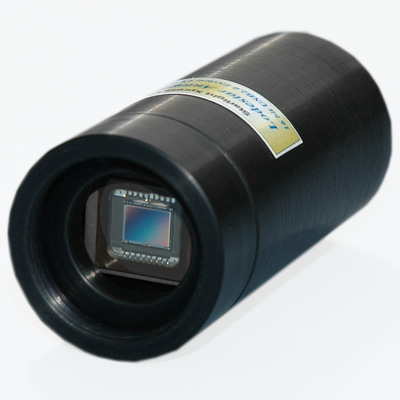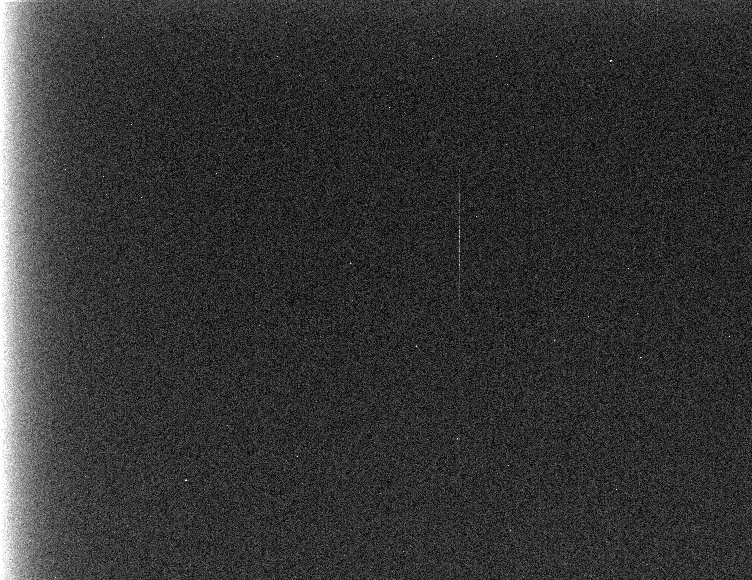|
Lodestar vs SXV-H5 by Lorenzo Comolli (thanks to Giosuè Ghioldi for testing with his telescope and SXV-H5) Written in June 2011 |
 |
 |
| The
two tested cameras: from left Lodestar and
SXV-H5 (courtesy of Starlight Xpress) |
|
Introduction
By the way, I'd like to remark a false myth along amateurs: "for guiding also a bad camera, even color, will suffice". This is false, for many reasons: the main one is that for high accuracy guiding the SNR of the guide star is fundamental; moreover a more accurate camera can be used with up to 5 times lower image scale, allowing to get a far more easy search of the guide star.
Lodestar
Lodestar guider is my actual guiding camera from late 2010. I'm very happy with it: this is a big step forward respect to my previous guiders: the old SBIG ST4 and a Philips Vesta Pro modified with a BW chip. The image quality is outstanding and I've successfully used not only for guiding. Maybe this is not a perfect camera (see some remarks here), but it comes very near. One of the first noted characteristics is simplicity: simple to mount (only 70 g weight, 31.8 mm external diameter), simple to connect to PC and power (single USB2 cable), simple to connect to the telescope (single ST4-compatible cable), simple to connect to software (all the most used software packages are supported).
SXV-H5
This camera is not strictly speaking a pure guider, as - when it was designed - I suppose it was mainly intended to substitute the successful HX-516, a great imaging camera that in the late '90s produced great deep-sky and planetary works. Respect to Lodestar, the dimensions, mass and cabling are quite larger, making the usage less simple. Moreover, being cooled, the power requirement is more heavy.
| Comparison |
||
| Characteristics | Lodestar | SXV-H5 |
| Chip |
Sony
ICX429ALL interline |
Sony
ICX424AL progressive |
| # pix X | 752 | 660 |
| # pix Y | 580 | 494 |
| Total pixels | 436160 | 326040 |
| Relative total pixels | 134% | 100% |
| Dim pix X [um] | 8.6 | 7.4 |
| Dim pix Y [um] | 8.3 | 7.4 |
| Relative average dim | 114% | 100% |
| Sensor dim X [mm] | 6.47 | 4.88 |
| Sensor dim Y [mm] | 4.81 | 3.66 |
| Area [mm^2] | 31.1 | 17.9 |
| Relative area | 174% | 100% |
| Cooling | no | yes |
| ADC bit | 16 | 16 |
| Download time [s] | <0.2 | <0.2 |
| Readout |
two
independent readouts for even and odd lines |
single
reading for all lines |
| Quantum
efficiency |
See figure below |
|
| Weight of head [g] | 70 | 311 |
| Weight of power supply [g] | 0 | 671 |
| Needed cables | 1
USB 1 ST4 |
1
USB 1 ST4 2 power |
| Current [I] | 0.5 | 0.7 |
| Voltage [V] | 5 | 12 |
| Power [W] | 2.5 | 8.4 |
| Relative power | 30% | 100% |
| Price (new 2011) [€] | 510 | - |
| Price (used 2011) [€] | ? | 500 |
| Links to manufacturer |
Lodestar |
SXV-H5 |

Comparison of the two cameras relative quantum efficiency
A simple test setup was used, composed of a typical guiding refractor, mounted on a bigger imaging refractor. Both were mounted on a heavy duty equatorial mount. Here are the instruments characteristics.
- Guiding scope (with the guiding cameras at direct focus): Vixen 80ED, apochromatic refractor, 80 mm diameter, f/8, 640 mm focal length.
- Main scope (not used): Takahashi FS152, apochromatic refractor, 152 mm diameter, f/8, 1216 mm focal length.
- Mount: 10Micron GM2000 QCI, German equatorial mount, 45 kg max load
- Location: Saronno (VA), a very light polluted city in the Po Valley, Italy.
- Temperature: about +20 °C
Test protocol
A series of images of the M82 galaxy were made with both cameras, in a total time of about 30 minutes, when the object was very high in the clear sky, about 70°. The sky conditions were stable and the whole sky was clear. Here are the registered images:
| Exposure |
Lodestar |
SXV-H5 |
| 1
s |
5
exp |
5 exp |
| 10
s |
5 exp | 5 exp |
| 30
s |
5 exp | 5 exp |
| dark
1 s |
5 exp | 5 exp |
| dark
10 s |
5 exp | 5 exp |
| dark
30 s |
5 exp | 5 exp |
 |
 |
|
Lodestar Dark, 1 s exp, median 5 frames |
SXV-H5 Dark, 1 s exp, median 5 frames |
| Here
are images at 50% resolution. Click on the
images for 100%. |
|
The analysis of the recorded images was conducted with respect to a few aspects.
- SNR of the guide star:
the better the SNR (signal to noise ratio), the better
the guiding accuracy. This is very frequently a highly
underestimated factor in guiding, but this is the key to a good
subpixel accuracy. Cameras with high
sensitivity and quality, usually connected to a higher
number of bits, produce better results. Both cameras
have 16 bits and produced very similar SNR, so that
there is virtually no difference in the two, regarding
guiding accuracy due to subpixel centroid measurement.
See "Reference star
SNR" in the table below.
- Background noise:
to measure this quantity, the standard deviation of the
background must be compared relative to the sensitivity,
measured by means of the flux intensity of a reference
star. The result is similar in the two, being only a
little better in Lodestar. Oddly the relative std of
Lodestar improves with longer exposures. See "Std relative to flux"
in the table below.
- FWHM of the guide
star: the pixel dimension is only a little
different, being the average dimension of the
rectangular pixels of Lodestar only 14% larger than the
square pixels of SXV-H5. Thus the latter is able, in
theory, to get smaller stars (measured in arcseconds).
The measurements showed no sign of this but maybe a
better focusing of both can enhance the difference. Or,
more likely, the seeing was limiting the measurements,
to about 3.5", a value quite usual from the observing
location. See "Fwhm
["]" in the table below.
- Hot pixels:
the approximate number of hot pixel was measured in the
1 s dark frame. This is the most significant
exposure, as a guider image frequently is used without
dark calibration, and so a hot pixel can produce a
spurious signal that can ruin the guiding. Both cameras
were found to produce very few hot pixels (Lodestar ~30,
SXV-H5 ~2), and the SXV-H5 is nearly perfect, being
cooled. The brightness of the hottest pixel was found in
the Lodestar to be 273 times the standard deviation of
the background and 26 times in the SXV-H5. See "Number of hot pix (approx)"
in the dark data table below.
 |
| Comparison of
images of the M82 galaxy. 80ED Vixen
refractor, 640 mm focal length. With the 1 s
exposure, the faintest star is the one East of
M82, mag. 12.9, snr 3. Click on the image for 100% |
| M81 average | 5 x 1 s | 5 x 10 s | 5 x 30 s | |||
| Camera | Lodestar | SXV-H5 | Lodestar | SXV-H5 | Lodestar | SXV-H5 |
| Reference star flux | 5020 | 10224 | 100255 | 103371 | 258849 | 274615 |
| Flux relative to SXV-H5 | 49% | 100% | 97% | 100% | 94% | 100% |
| Reference star SNR | 70.6 | 64.35 | 562 | 499 | 677 | 762 |
| Std of background | 6.48 | 14.52 | 12.6 | 19.4 | 20.6 | 29.8 |
| Std relative to flux | 91% | 100% | 67% | 100% | 73% | 100% |
| Fwhm [pix] | 1.208 | 1.289 | 1.199 | 1.319 | 1.724 | 1.63 |
| Fwhm ["] | 3.29 | 3.51 | 3.26 | 3.59 | 4.69 | 4.43 |
| Dark median 5 x 1 s | Lodestar | SXV-H5 |
| Std of background | 8.7 | 13.9 |
| Ave | 1894 | 1478 |
| Max | 4266 | 1846 |
| Max-Ave | 2372 | 368 |
| Max-Ave normalized | 273 | 26 |
| Ave+20std | 2068.0 | 1756.0 |
| Ave+10std | 1981.0 | 1617.0 |
| Number of hot pix (approx) | 30 | 2 |
Conclusions
Both cameras was found to have similar (great) sensitivities and characteristics. The Lodestar has many advantages such as small size, small weight, small power consumption, few cables, larger sensor area. On the other hand SXV-H5 has fewer hot pixels thanks to cooling and a little better resolution, yielding to a theoretical little better guiding accuracy, when the same focal length is used. From an image quality point of view, the cameras finished in a draw: the SNR of the stars, the most important quantity for subpixel measurement, was found to be nearly the same. The test results can be summarized in the table below.
| Test results | |||
| Image quality | tie | ||
| Sensitivity | tie | ||
| SNR of guide star | tie | ||
| Number of pixels | Little better Lodestar | ||
| Hot pixels | Little better SXV-H5 | ||
| Pixel dimension (smaller is better) | Little better SXV-H5 | ||
| Dimensions | Much lighter Lodestar | ||
| Cable complexity | Much better Lodestar | ||
| Power consumption | Much better Lodestar | ||
| Sensor area |
Much better Lodestar | ||
Acknowledgments: I'd like to thank my friend Giosuè for testing together; Mauro and Giancarlo for added tips.